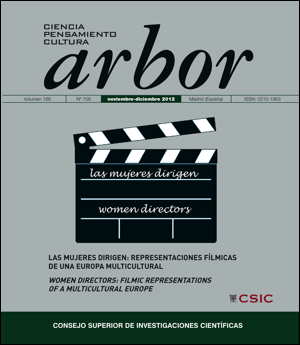Fariza Benlyazid: Feminist cinema dealing with personal identity
DOI:
https://doi.org/10.3989/arbor.2012.758n6005Keywords:
Europe/North Africa, Farida Benlyazid, Islam, women, identityAbstract
This article analyses Tangier’s director Farida Benlyazid’s personal vision of the identity conflict of the Muslim Moroccan woman (a conflict deriving from the tension between the French colonial culture and the Arab-Muslim one) as presented in her opera prima Bab samá maftúh / A Door to the Sky (1988), based on a script written by herself. Within the context of Moroccan cinema, Benlyazid is a pioneer in the treatment of the Muslim woman’s role in the Moroccan patriarchal system due both to her peculiar understanding of feminism and to her multicultural upbringing, which allows her to deploy a symbolic language to universalize her films and transmit the value of rites and atavistic rituals of Morocco’s popular collective imaginary and of her own intimate imaginary.
Downloads
References
Al-Fatouh, Ahmed: “Homage à Farida Belyazid”. Disponible en http://forumcultureltanger.org/index.php?view=article=catid=40%3Acinema&id=51. Consulta 14/03/2011.
Benlyazid, Farida (1996): “La terrasse: le lieu du posible”, Qantara: magazine des cultures árabe et méditerranéenne 18, 66-67.
Benlyazid, Farida: “¿Por qué el pañuelo?” El País.es. Disponible en http://www.elpais.es/articulo.html?xref=2003091...pe=Tes&anchor=elpepiopi&print=1&d_date=20030914. Consulta: 12/12/2010.
Benlyazid, Farida (2007): “El cine dirigido por mujeres”, Quaderns de la Mediterrània 7, 222-224.
Cortés, Julio (1999): El Corán, Barcelona, Herder.
Durand, Gilbert (1982): Las estructuras antropológicas de lo imaginario, Madrid, Taurus.
Fernández Suzor, Cecilia (2005): “La directora de cine, Farida Benlyazid, que acaba de dirigir una coproducción hispanomarroquí, espera que surjan distribuidores españoles interesados por el cine marroquí”, Afkar-Ideas 6, 108-109.
Ghassan, Ascha (1989): Du statut inférieur de la femme en Islam, Paris, L´Harmattan.
Goytisolo, Juan (1988): Ver sin ser vista. La mujer en el Islam, Alquibla, cap. 8, Madrid, TVE (27,55 min.).
Hadj Nasser, Badia (2007). El velo al desnudo, Alcalá la Real, Alcalá.
Hamdaoui, Djamil: “Sinima al-mar´ati fil-Magrib”. Disponible en http://www.almothaqaf.com/index.php?option=com_content&view=article&id=7926:2009-11-25-13-11-25. Consulta: 31/01/2011.
Hillauer, Rebecca (2006): Encyclopaedia of Arab Women Filmmakers, Cairo, American University in Cairo Press. http://dx.doi.org/10.5743/cairo/9789774249433.001.0001
Jung, Carl G. (1948): Simbología del espíritu, Madrid, Fondo de Cultura Económica, 1998.
Rimbaud, Arthur (1873): Una temporada en el infierno, Santa Fe, El Cid Editor, 2004.
Sabah, Abdelkhalek (2010): “Aux hommes revenaient jadis la création et la maîtrise de la technique, tandis que les femmes étaient cantonnées à être de petits mains: Y a-t-il une femme derrière la caméra?” Disponible en: http://www.libe.ma. Consulta: 14/03/2011.
Shafik, Viola (1998): Arab Cinema: History and Cultural Identity, Cairo, American University in Cairo Press.
Schneider, Simona (2008): “Tanger fait son cinema”, La pensée de midi. Tanger vielle frontière 23, 80-89. Disponible en http://www.lapenseedemidi.org/. Consulta: 3/1/2011.
Torres, Katjia (2006): “Estatus jurídicosocial de la mujer en Marruecos”, en Desde Andalucía: Mujeres del Mediterráneo, ed. Mercedes Arriaga Flórez, Sevilla, ArCiBel, 465-497.
Downloads
Published
How to Cite
Issue
Section
License
Copyright (c) 2012 Consejo Superior de Investigaciones Científicas (CSIC)

This work is licensed under a Creative Commons Attribution 4.0 International License.
© CSIC. Manuscripts published in both the printed and online versions of this Journal are the property of Consejo Superior de Investigaciones Científicas, and quoting this source is a requirement for any partial or full reproduction.
All contents of this electronic edition, except where otherwise noted, are distributed under a “Creative Commons Attribution 4.0 International” (CC BY 4.0) License. You may read the basic information and the legal text of the license. The indication of the CC BY 4.0 License must be expressly stated in this way when necessary.
Self-archiving in repositories, personal webpages or similar, of any version other than the published by the Editor, is not allowed.














